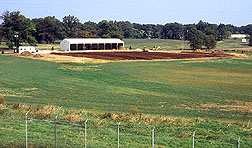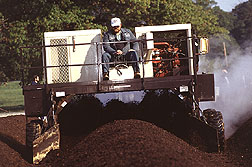"Designer" Composts To Fight Farm Pollutants
|
|
The Agricultural Research Service officially opened its composting center for organic byproducts in Beltsville, Maryland, this past fall‹just as the debate over Pfiesteria in some Chesapeake Bay tributaries captured national attention.
Pfiesteria piscicida and other Pfiesteria-like microscopic organisms are dinoflagellates. These tiny, complex creatures sometimes behave like plants and sometimes like animals. In one of two dozen or more life stages, Pfiesteria and its cousins can produce a toxin that kills fish and harms people who come in close contact with the toxin.
The new composting center offers a model for two recommendations made by a Pfiesteria commission formed by Maryland's governor.
One recommendation is to compost chicken litter. The other: Install grass or tree buffer zones around farm fields to filter out nutrients thought to be responsible for Pfiesteria blooms.
The 2-acre composting site at the Beltsville Agricultural Research Center (BARC) is surrounded on three sides by an 8-acre field of orchardgrass. This buffer zone sits between the compost pad and the tree-lined banks of Beaver Dam Creek, which teems with beavers, turtles, and other wildlife. The creek flows into Indian Creek, which in turn feeds the Anacostia River, a tributary of the Chesapeake Bay. Near Beaver Dam Creek is a bird-watcher's paradise, a wetlands that even plays host to great blue herons. Canada geese fly over the compost center to feed in BARC's grain fields or swim in its ponds.
"We harvest the orchardgrass for hay four times a year and feed it to cattle. Then we recycle their manure and hay bedding back here again," says BARC director Phyllis E. Johnson.
The two-way street is a mark of the facility. The composts it produces will go to the farm's researchers for testing in next year's sustainable and organic farming projects. Even its vehicular traffic is two-way: Almost daily, dump trucks arrive carrying manure, livestock bedding, landscape trimmings, greenhouse discards, wood chips, and leaves. The trucks depart with loads of finished compost to use as mulch in landscaping and farm research.
Last October 21, for example, a front-end loader filled a truck with 6 cubic yards of finished compost, and the truck headed off to deliver it as landscaping mulch around a nearby Agricultural Research Serviceoffice building. The truck made five more return trips to complete the job.
The same day, according to a hauler's daily log, incoming trucks arrived with 30 cubic yards of wood shavings--used livestock bedding--and 67 cubic yards of dairy and poultry manure.
At any one time, the 77,000-square-foot composting pad between the shed and the orchardgrass buffer holds about 900 tons of composting materials. These are stacked in about 20 neat rows, each 160 feet long, 5 feet wide, and 40 inches high.
The windrows, as they're called, represent a simple method of composting, which relies on regular turning so that heat generated by decomposition can "cook" compost from the inside out. Frequent turning makes for a uniform mixture. The finished product shows no sign of the compost's origins: woodchips, manure, used animal bedding, or plant residue such as cornstalks and discarded ornamentals.
|
|
Lawrence J. Sikora, the ARS microbiologist in charge of the composting research center, says the 8-inch-thick composting pad has held up well under all this weight during its first year. He's especially proud because the pad itself is made partly of recycled materials: coal ash from area power plants and cement kiln dust. It was built by working these materials, along with quicklime and cement, into the existing clay subsoil.
Designing Composts for Special Uses
Sikora and his colleagues will use the facility to find better ways to make composts from a blend of farm, industrial, and urban materials.
"We call them designer composts because we will tailor-make them in hopes of solving particular problems such as vegetable diseases," he says.
"Compost has an inherent ability to control certain diseases--an ability we can enhance with the right ingredients, such as manure type and the right age or maturity. We can also add disease-fighting microorganisms. Liquids leaching from the compost pile can be used as a liquid disease-control spray.
"By adding a specific benefit to compost, we add enough value that an entrepreneur could justify shipping it hundreds of miles beyond the traditional 50- to 100-mile limit of today's commercial compost operations," says Sikora.
The scientists will test composts in six concrete bins in the equipment shed. Each bin, about twice the size of a typical backyard compost pile, has a separate drainage system, so all compost "tea" drains into separate containers. The scientists can analyze the liquids for nutrients, chemicals, and disease organisms.
Sikora and his colleagues often seek feedback from regulatory agencies and industries they invite to the composting center, such as the U.S. Food and Drug Administration and a number of food associations.
Sikora says the first research projects will include finding better ways to reduce chances of nutrient pollution of waterways, kill disease organisms such as Escherichia coli O157:H7, and control odors.
"Composting stabilizes nutrients such as nitrogen and phosphorus, making them less likely to leach into groundwater," he says.
While the composting center is a research facility, it also provides vital recycling services for BARC's 7,000-acre research farm, which includes greenhouses, animal barns, crop fields, pastures, and lawns and other landscaped areas. The BARC "farm" produces manure from 650 head of cattle, 600 pigs, 250 sheep, and 3,500 chickens and turkeys--along with their used bedding--and plant residue from its greenhouse and landscape operations. The compost facility recycles all this organic residue.
This helps the farm comply with voluntary state restrictions designed to keep nitrogen and phosphorus out of the Chesapeake Bay and its tributaries.
Where There's Heat, There's Compost
The operational side of the compost facility is Randy Townsend's turf. Townsend is an ARS employee who is certified as a compost operator by the Maryland State Department of Agriculture.
Townsend says the signature BARC compost--a mixture of the same ingredients produced year after year--will be a blend of dairy manure, shredded wood chips, and hay.
"We will use all of it on the research farm," Townsend says. "Researchers require a steady and consistent supply for multiyear experiments."
Townsend has office space in a nearby trailer he shares with a mini-lab equipped with an oven for drying compost to measure its moisture content. He uses special vacuum bottles test the maturity of compost by monitoring its reheating potential: If the temperature of a sample rises more than 35 degrees above the ambient air temperature, the compost is not ready to use.
To speed up composting, Townsend runs a windrow turner over the rows once a week. The turner has six rows of blades that rake through the piles, tossing and reforming them while letting air in. He will turn the piles more often if they're not getting enough air. He determines this with a 5-foot probe equipped with sensors for oxygen, temperature, and carbon dioxide.
Townsend explains that a temperature of 131oF for more than 2 weeks is enough to kill all disease organisms and weed seeds. When the temperature in a pile drops to about 115oF to 120oF, the compost is ready to be used on the farm.
"That usually occurs in 12 weeks," Townsend says. He occasionally verifies the compost's readiness with the vacuum bottle test.
Even Townsend's neat operational piles are useful to Sikora. "We are keeping careful records of various mixtures to see which work best, in terms of speedy compost," he says. He points to three windrows, each containing a different combination of animal manure, bedding, and tomato and other vegetable residues.
With over 20,000 cubic yards of BARC organics expected to be trucked in before the year ends, Sikora will have plenty of opportunities to fine-tune designer recipes.--By Don Comis, Agricultural Research Service Information Staff, 6303 Ivy Lane, Greenbelt, Maryland 20770, phone (301) 344-2748.
Lawrence J. Sikora is at the USDA-ARS Soil Microbial Systems Laboratory, Bldg. 318, 10300 Baltimore Ave., Beltsville, MD 20705-2350; phone (301) 504-9384, fax (301) 504-8370, e-mail
Randall K. Townsend is at the USDA-ARS Compost Research Facility, Bldg. 218-P, 10300 Baltimore Ave., Beltsville, MD 20705-2350; phone (301) 504-6762, fax (301) 504-8403.
"Designer" Composts To Fight Farm Pollutants was published in the May 1998 issue of Agricultural Research magazine. Click here to see this issue's table of contents.








